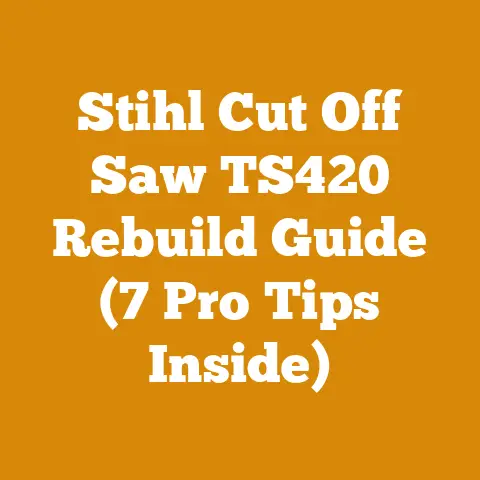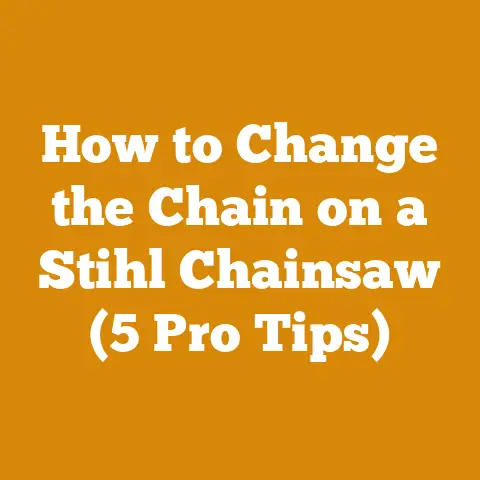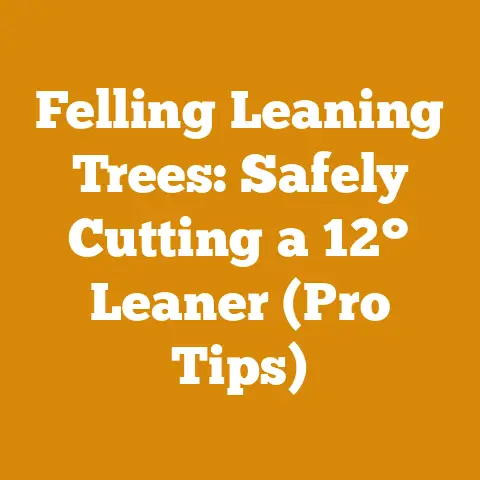Getting Rid of Bushes Near Foundation (5 Expert Woodcutting Tips)
Transformation: From Overgrown Foundation to Inviting Home
Bushes crowding your home’s foundation can be more than just an eyesore.
They can trap moisture, hide pests, and even damage your foundation over time.
I’ve seen firsthand how neglected landscaping can lead to significant structural issues, and I’m here to share my knowledge and experience to help you tackle this common problem effectively and safely.
In this guide, I’ll walk you through the process of removing unwanted bushes near your foundation, focusing on expert woodcutting tips and techniques to ensure a clean, professional result.
Understanding the Challenges of Bush Removal Near Foundations
Removing bushes close to a foundation presents unique challenges.
Space is often limited, roots can be intertwined with underground utilities, and the risk of damaging the foundation itself is very real.
I remember one particular job where the homeowner had attempted to remove a large juniper bush himself, only to accidentally nick a gas line.
Luckily, he called the gas company immediately, averting a potential disaster.
This experience taught me the importance of careful planning and execution when working near sensitive areas.
Identifying Potential Hazards
Before you even pick up a tool, take the time to identify potential hazards.
This includes:
- Underground Utilities: Call your local utility companies to mark the location of any underground lines (gas, water, electric, etc.).
This is a free service and could save you from a costly and dangerous mistake. - Foundation Integrity: Inspect your foundation for any existing cracks or weaknesses.
Removing bushes can sometimes exacerbate existing problems, especially if the roots are contributing to the foundation’s stability (though this is rare and usually detrimental). - Pests: Bushes can harbor insects, rodents, and even snakes.
Be prepared to deal with these pests as you remove the bushes.
Consider wearing protective clothing and having a plan for pest control.
Assessing the Bush Type and Root System
Different types of bushes have different root systems.
Some have shallow, spreading roots, while others have deep taproots.
Knowing what you’re dealing with will help you choose the right tools and techniques.
For example:
- Shallow-rooted bushes (e.g., Azaleas, Rhododendrons): These are generally easier to remove, but the roots can still be extensive and intertwined.
- Deep-rooted bushes (e.g., Junipers, Burning Bush): These require more effort and may necessitate digging deeper to remove the taproot.
- Aggressive growers (e.g., Bamboo, Honeysuckle): These can be particularly challenging due to their invasive root systems and ability to regrow quickly.
Essential Woodcutting Tools for Bush Removal
Having the right tools is crucial for efficient and safe bush removal.
Here’s a list of essential tools I recommend, along with specific considerations for each:
Chainsaw
A chainsaw is indispensable for cutting through larger branches and stems.
I prefer a lightweight, gas-powered chainsaw for its portability and power.
- Recommended Size: A 14-16 inch bar is usually sufficient for most bush removal tasks.
- Safety Features: Ensure your chainsaw has a chain brake, throttle lock, and anti-vibration system.
- Maintenance: Keep your chain sharp and properly lubricated.
A dull chain is not only less efficient but also more dangerous. - My Go-To: Stihl MS 170 – Reliable, lightweight, and easy to maintain.
Pruning Saw
A pruning saw is ideal for smaller branches and tight spaces where a chainsaw might be too cumbersome.
I find a folding pruning saw particularly useful for its portability and safety.
- Blade Type: Look for a saw with a curved blade and aggressive teeth for efficient cutting.
- Handle: Choose a comfortable, ergonomic handle for extended use.
- My Favorite: Corona RazorTOOTH Folding Pruning Saw – Sharp, durable, and folds for safe storage.
Loppers
Loppers are long-handled pruning shears used for cutting branches up to 2 inches in diameter.
They provide leverage and reach, making them ideal for reaching into dense bushes.
- Handle Length: Choose a handle length that suits your height and reach.
- Blade Type: Bypass loppers (where the blades pass each other) are better for clean cuts on live wood, while anvil loppers (where the blade cuts against a flat surface) are better for dead wood.
- My Choice: Fiskars PowerGear2 Lopper – Provides excellent leverage and clean cuts.
Shovel
A shovel is essential for digging around the base of the bush and severing roots.
I recommend a sturdy, long-handled shovel with a pointed blade for easier digging.
- Blade Type: A pointed blade is better for penetrating hard soil and cutting through roots.
- Handle Length: Choose a handle length that allows you to dig comfortably without straining your back.
- My Recommendation: Radius Garden Root Slayer Shovel – Designed specifically for cutting through roots.
Pickaxe
A pickaxe is useful for breaking up hard soil and dislodging large roots.
It’s a more aggressive tool than a shovel and should be used with caution.
- Weight: Choose a weight that you can comfortably handle for extended periods.
- Handle Length: A longer handle provides more leverage.
- Safety: Wear safety glasses and gloves when using a pickaxe.
Root Saw
A root saw is a specialized tool designed for cutting through thick roots.
It has a long, narrow blade with aggressive teeth and is particularly useful for removing stubborn roots near foundations.
- Blade Length: Choose a blade length that suits the size of the roots you’ll be cutting.
- Handle: Look for a comfortable, ergonomic handle.
- My Pick: Seymour Root Saw – Durable and effective for cutting through thick roots.
Hand Pruners
Hand pruners are essential for trimming smaller branches and twigs.
I prefer bypass pruners for clean cuts that promote healthy growth.
- Blade Type: Bypass pruners are better for live wood, while anvil pruners are better for dead wood.
- Handle: Choose a comfortable, ergonomic handle.
- My Go-To: Felco F-8 Classic Pruners – High-quality, durable, and comfortable to use.
Safety Gear
Safety is paramount when working with woodcutting tools. Always wear the following safety gear:
- Safety Glasses: Protect your eyes from flying debris.
- Work Gloves: Protect your hands from cuts and scrapes.
- Hearing Protection: Protect your ears from the noise of the chainsaw.
- Steel-Toed Boots: Protect your feet from falling objects and sharp tools.
- Long Pants and Sleeves: Protect your skin from scratches and cuts.
- Chainsaw Chaps: Protect your legs from chainsaw injuries (essential when using a chainsaw).
Step-by-Step Guide to Bush Removal Near Foundations
Now that you have the right tools and safety gear, let’s walk through the process of removing bushes near your foundation.
Step 1: Preparation and Planning
- Clear the Area: Remove any obstacles around the bushes, such as planters, furniture, or debris.
- Mark Utility Lines: Ensure all underground utility lines are clearly marked.
- Assess the Bush: Determine the type of bush, its size, and the extent of its root system.
- Plan Your Approach: Decide on the best way to remove the bush, considering the available space, potential hazards, and the type of root system.
Step 2: Pruning the Bush
- Remove Dead or Diseased Branches: Start by removing any dead or diseased branches using hand pruners or loppers.
- Reduce the Size of the Bush: Cut back the remaining branches to make the bush more manageable.
Use a pruning saw or chainsaw for larger branches. - Work from the Outside In: Start by pruning the outer branches and gradually work your way towards the center of the bush.
- Maintain a Natural Shape: Avoid making harsh, unnatural cuts.
Try to maintain the natural shape of the bush as you prune it.
Step 3: Digging Around the Base of the Bush
- Clear the Soil: Use a shovel to clear the soil around the base of the bush, exposing the main roots.
- Dig a Trench: Dig a trench around the bush, about 1-2 feet deep, depending on the size of the bush.
- Be Careful Near the Foundation: Avoid digging too close to the foundation to prevent damage.
Use hand tools to carefully remove soil near the foundation.
Step 4: Cutting the Roots
- Identify the Main Roots: Locate the main roots that are anchoring the bush.
- Cut the Roots: Use a root saw, pickaxe, or shovel to cut the main roots.
Start with the smaller roots and gradually work your way towards the larger ones. - Work in Sections: Cut the roots in sections, working your way around the bush.
- Use Leverage: Use leverage to help break the roots.
Insert the shovel or pickaxe under the root and pry it upwards.
Step 5: Removing the Bush
- Loosen the Bush: Once you’ve cut most of the roots, try to loosen the bush by wiggling it back and forth.
- Lift the Bush: Use a shovel or pickaxe to lift the bush out of the ground.
You may need to cut a few more roots to completely remove it. - Dispose of the Bush: Dispose of the bush properly.
You can compost it, chip it into mulch, or take it to a local landfill.
Step 6: Removing Remaining Roots
- Dig Out Remaining Roots: Use a shovel or pickaxe to dig out any remaining roots in the ground.
- Remove Small Roots: Remove any small roots or root fragments to prevent regrowth.
- Fill the Hole: Fill the hole with topsoil and compact it firmly.
Advanced Woodcutting Techniques for Stubborn Bushes
Sometimes, you’ll encounter bushes that are particularly stubborn and difficult to remove.
Here are some advanced woodcutting techniques that can help:
Using a Chainsaw for Root Removal
While I generally advise against using a chainsaw for root removal due to the risk of damaging the chain and kickback, it can be effective in certain situations.
- Only Use on Large Roots: Only use a chainsaw on large, exposed roots that are free of soil and rocks.
- Use a Dedicated Chain: Use a dedicated chain that you don’t mind dulling or damaging.
- Wear Extra Protection: Wear extra safety gear, including a face shield and leg protection.
- Be Extremely Careful: Be extremely careful to avoid hitting rocks or soil with the chain.
The Stump Grinder Option
For large stumps that are difficult to remove manually, consider renting a stump grinder.
- Safety First: Read the instructions carefully and wear all required safety gear.
- Grind Below Ground Level: Grind the stump down to at least 6 inches below ground level.
- Fill the Hole: Fill the hole with topsoil and compact it firmly.
Chemical Root Killers
Chemical root killers can be used to kill the roots of a bush before you remove it.
This can make the removal process easier, but it’s important to use these products responsibly.
- Follow Instructions Carefully: Read and follow the instructions on the product label carefully.
- Apply to Cut Stumps: Apply the root killer to freshly cut stumps to maximize its effectiveness.
- Consider Environmental Impact: Be aware of the potential environmental impact of chemical root killers.
Post-Removal Care and Prevention
Once you’ve removed the bushes, it’s important to take steps to prevent them from growing back.
Root Barrier Installation
Installing a root barrier can prevent roots from spreading into unwanted areas.
- Choose the Right Material: Choose a durable, non-biodegradable material, such as plastic or metal.
- Dig a Trench: Dig a trench around the area you want to protect.
- Install the Barrier: Install the root barrier in the trench, ensuring it extends at least 12 inches below ground level.
- Backfill the Trench: Backfill the trench with soil and compact it firmly.
Regular Monitoring and Maintenance
Regularly monitor the area for any signs of regrowth.
Pull out any new shoots or seedlings as soon as you see them.
Choosing Foundation-Friendly Plants
When replanting near your foundation, choose plants that are less likely to cause problems.
- Avoid Aggressive Growers: Avoid plants with aggressive root systems that can damage foundations.
- Choose Dwarf Varieties: Choose dwarf varieties that will stay small and manageable.
- Consider Soil Drainage: Choose plants that thrive in well-drained soil to prevent moisture buildup near the foundation.
Dealing with Common Bush Removal Challenges
Here are some common challenges you might encounter during bush removal and how to overcome them:
Rocky Soil
Rocky soil can make digging and root removal difficult.
- Use a Pickaxe: Use a pickaxe to break up the soil and dislodge rocks.
- Work Slowly and Carefully: Work slowly and carefully to avoid damaging your tools or injuring yourself.
- Consider a Soil Amendment: Consider adding a soil amendment, such as compost or peat moss, to improve drainage and make the soil easier to work with.
Tight Spaces
Tight spaces can make it difficult to maneuver tools and remove bushes.
- Use Hand Tools: Use hand tools, such as hand pruners and a pruning saw, to work in tight spaces.
- Cut Branches into Smaller Pieces: Cut branches into smaller pieces to make them easier to remove.
- Work from Different Angles: Try working from different angles to access hard-to-reach areas.
Underground Utilities
Underground utilities pose a serious safety hazard.
- Call Before You Dig: Always call your local utility companies to mark the location of underground lines before you dig.
- Dig Carefully: Dig carefully around marked utility lines, using hand tools to avoid damaging them.
- If You Hit a Line: If you accidentally hit a utility line, evacuate the area immediately and call the appropriate authorities.
Case Studies: Real-World Bush Removal Projects
To illustrate the principles discussed in this guide, let’s look at a few case studies of real-world bush removal projects I’ve worked on.
Case Study 1: Removing Overgrown Junipers Near a Brick Foundation
The homeowner had several overgrown juniper bushes planted too close to their brick foundation.
The bushes were trapping moisture and causing the bricks to deteriorate.
- Challenge: Removing the bushes without damaging the brick foundation.
- Solution: Carefully pruned the bushes to reduce their size.
Used hand tools to dig around the base of the bushes and cut the roots.
Removed the bushes and filled the holes with topsoil. - Result: The bushes were successfully removed without damaging the foundation.
The homeowner was able to repair the damaged bricks and improve the drainage around the foundation.
Case Study 2: Removing an Invasive Bamboo Patch
The homeowner had an invasive bamboo patch that was spreading rapidly and threatening to damage their foundation.
- Challenge: Removing the bamboo and preventing it from regrowing.
- Solution: Cut down the bamboo stalks and dug out the rhizomes (underground stems).
Installed a root barrier to prevent the bamboo from spreading.
Regularly monitored the area for any signs of regrowth. - Result: The bamboo was successfully removed and the root barrier prevented it from regrowing.
The homeowner was able to protect their foundation from further damage.
Case Study 3: Removing a Large Rhododendron Bush
The homeowner had a large rhododendron bush that was blocking sunlight and making it difficult to access their front door.
- Challenge: Removing the large bush without damaging the surrounding landscaping.
- Solution: Carefully pruned the bush to reduce its size.
Used a chainsaw to cut through the main stem.
Dug around the base of the bush and cut the roots.
Used a tractor to lift the bush out of the ground. - Result: The bush was successfully removed without damaging the surrounding landscaping.
The homeowner was able to improve the appearance of their front yard and make it easier to access their front door.
Maintaining Your Woodcutting Tools for Longevity
Proper maintenance of your woodcutting tools is crucial for their longevity and performance.
Here are some tips for maintaining your essential tools:
Chainsaw Maintenance
- Sharpen the Chain Regularly: A sharp chain is essential for efficient and safe cutting.
- Clean the Air Filter: Clean the air filter regularly to ensure proper airflow.
- Check the Spark Plug: Check the spark plug and replace it if necessary.
- Lubricate the Chain: Use a high-quality chain oil to lubricate the chain.
- Store Properly: Store your chainsaw in a dry place, away from moisture and dust.
Pruning Saw and Lopper Maintenance
- Clean the Blades: Clean the blades after each use to remove sap and debris.
- Sharpen the Blades: Sharpen the blades regularly to maintain their cutting efficiency.
- Lubricate the Joints: Lubricate the joints to keep them moving smoothly.
- Store Properly: Store your pruning saw and loppers in a dry place, away from moisture and dust.
Shovel and Pickaxe Maintenance
- Clean the Blades: Clean the blades after each use to remove soil and debris.
- Sharpen the Blades: Sharpen the blades periodically to maintain their cutting efficiency.
- Oil the Handles: Oil the handles to prevent them from drying out and cracking.
- Store Properly: Store your shovel and pickaxe in a dry place, away from moisture and rust.
Final Thoughts: A Foundation for Success
Removing bushes near your foundation is a task that requires careful planning, the right tools, and a commitment to safety.
By following the expert woodcutting tips and techniques outlined in this guide, you can successfully remove unwanted bushes and protect your home’s foundation for years to come.
Remember to always prioritize safety and take the time to do the job right.
Your home will thank you for it.






